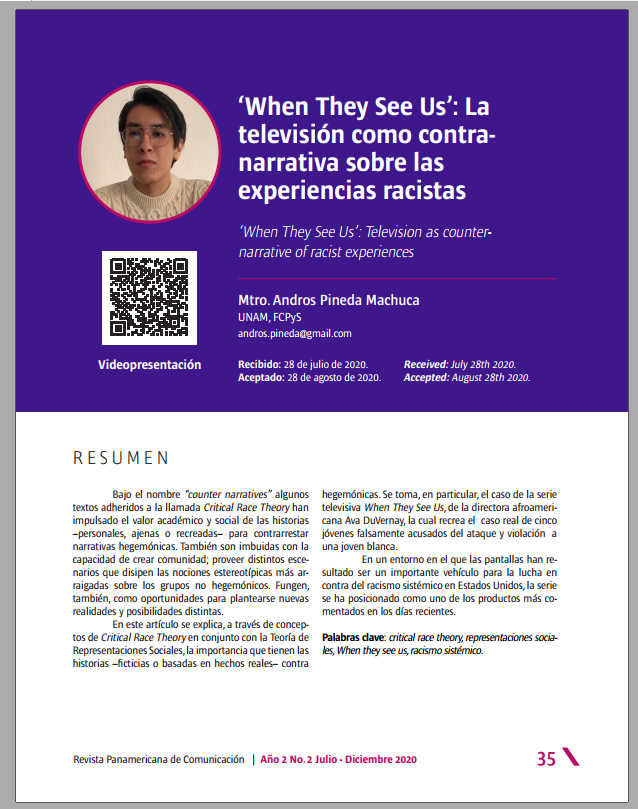‘When They See Us’: Television as counter-narrative of racist experiences
Main Article Content
Abstract
Under the name “counter narratives”, some critical race theory texts have promoted the academic and social value of stories –personal, someone else’s’ or recreated– and their power to counter hegemonic narratives. They’re also imbued with the capacity to create, as well as reaffirm, a sense of community and belonging, and capable of providing scenarios that could dispel some of the most deeply rooted stereotypical notions about non-hegemonic groups. They also function as opportunities to consider new realities and different possibilities. This article explains, through Critical Race Theory concepts, in conjunction with Social Representations Theory, the importance of stories –fictional or based on real events– against hegemonic racial considerations. In particular, it takes the case of the television series When They See Us, created by the African American director Ava DuVernay. The series recreates the real case of five young men falsely accused of the attack and rape of a young white woman. In a context in which screens have turned out to be an important tool in the fight against systemic racism in the United States, the series has positioned itself as one of the most discussed products in recent days.
Article Details
References
Brace, J. (2004) The Blind African Slave, or Memoirs of Boyrereau Brinch, Nicknamed Jeffrey Brace. The University of Wisconsin Press.
Fanon, F. (2019). Piel negra, máscaras blancas. Editorial Akal.
Lennard, K. (2015). Old purpouse, “New body”: The Birth of A Nation and the revival of the Ku Klux Klan. The Journal of the Guilded Age and Progressive Era, 14, 616- 620.
Kulaszewicz, Kassia E., «Racism and the Media: A Textual Analysis» (2015). Social Work Master’s Clinical Research Papers. 472.
Luther, C. A et al. (2012). Diversity in U.S. Mass Media. Wiley-Blackwell.
Matsuda, C. (1991). Voices of America: Accent, antidiscrimination law, and a jurisprudence for the last reconstruction. Yale Law Journal, 100, 1329-1407 citado en Solorzano, D., Yosso, T. (2002). Critical Race Methodology: Counter-Storytelling as an Analytical Framework for Education Research. Qualitative Inquiry, Volume 8 Number 1, 2002 23-44.
Moscovici, S. (1979). El psicoanálisis, su imagen y su público. Editorial Huemul.
Mugny, G., Carugati, F. (1985) L’intelligence au pluriel: les représentations sociales de l’ingelligence et son développement citado en Abric, J. (2001) Prácticas sociales y representaciones. Ediciones Coyoacán.
Rappaport, J. (2000). Community narratives: Tales of terror and joy. American Journal of Community Psychology, 28, 1–24.
Sampson, H. T. (2005). Swingin’ on the Ether Waves: A Chronological History in Radio and Television Programming, 1925–1955, Volumen 2. Scarecrow Press.
Schreider, M. (2012). Qualitative Content Analysis in Practice. SAGE.
Solorzano, D., Yosso, T. (2002). Critical Race Methodology: Counter-Storytelling as an Analytical Framework for Education Research. Qualitative Inquiry, Volume 8 Number 1, 2002 23-44
Array 101. (2020). When they See Us: A Learning Companion. Array 101. https://www.array101.org/
Bennett, A. (2019). ‘When They See Us’ Watched By More Than 23 Million Netflix Accounts Worldwide. Deadline.
https://deadline.com/2019/06/when-they-see-us-watched- by-more-than-23-million-netflix-accounts-worldwide-1202638036/
Zoller Seitz, Matt. (2019). How Ava DuVernay Made When They See Us, the Year’s Best Miniseries. Vulture. https://www.vulture.com/2019/09/ava-duvernay-when-they-see- us-netflix.html
Filmografía
DuVernay, A. (productora). (2016). 13th. [película]. Estados Unidos: Kandoo Films.
Griffith, D.W (productor). (1915). The Birth of a Nation. [película]. Estados Unidos:
David W. Griffith Corp.
Winfrey, O. (productora). (2014). Selma. [película]. Estados Unidos: Plan B Entertainment.
DuVernay, A. (productora). (2019). When they see us. [serie de televisión]. Estados Unidos: ARRAY.
Fonda, J, (productor). (1951–1953). The Amos ‘n Andy Show. [serie de televisión].
Estados Unidos: CBS.


